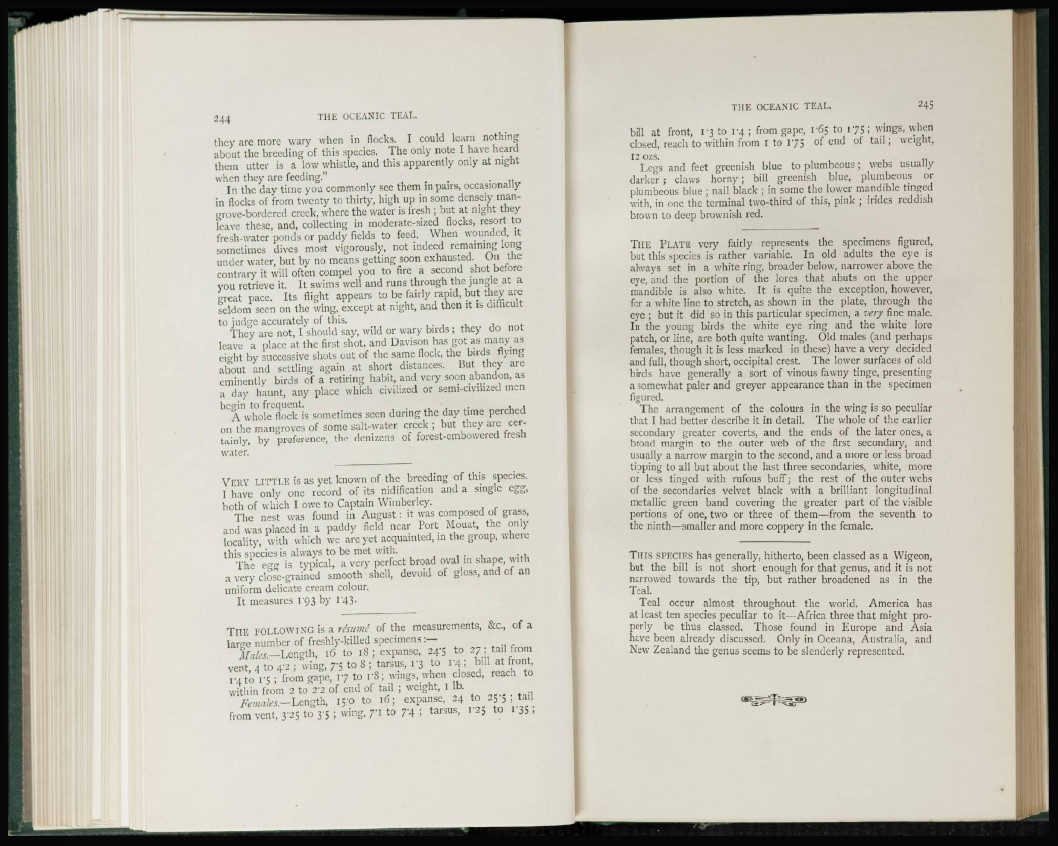
they are more wary when in flocks. I could learn nothing
about the breeding of this species. The only note I have heard
them utter is a low whistle, and this apparently only at night
when they are feeding."
In the day time you commonly sec them in pairs, occasionally
in flocks of from twenty to thirty, high up in some densely mangrove
bordered creek, where the water is fresh ; but at night they
leave these, and, collecting in moderate-sized flocks, resort to
fresh-water ponds or paddy fields to feed. When wounded, it
sometimes dives most vigorously, not indeed remaining long
under water, but by no means getting soon exhausted. On the
contrary it will often compel you to fire a second shot before
you retrieve it. It swims well and runs through the jungle at a
great pace. Its flight appears to be fairly rapid, but they are
seldom seen on the wing, except at night, and then it is difficult
to judge accurately of this.
They are not, I should say, wild or wary birds ; they do not
leave a place at the first shot, and Davison has got as many as
eight by successive shots out of the same flock, the birds flying
about and settling again at short distances. But they are
eminently birds of a retiring habit, and very soon abandon, as
a day haunt, any place which civilized or semi-civilized men
begin to frequent.
A whole flock is sometimes seen during the day time perched
on the mangroves of some salt-water creek ; but they are certainly,
by preference, the denizens of forest-embowered fresh
water.
VERY LITTLE is as yet known of the breeding of this species.
I have only one record of its nidification and a single egg,
both of which I owe to Captain Wimberley.
The nest was found in August : it was composed of grass,
and was placed in a paddy field near Port Mouat, the onlylocality,
with which we are yet acquainted, in the group, where
this species is always to be met with.
The egg is typical, a very perfect broad oval in shape, with
a very close-grained smooth shell, devoid of gloss, and of an
uniform delicate cream colour.
It measures I 93 by 143.
THE FOLLOWING is a resume of the measurements, &c, of a
lar<re number of freshly-killed specimens :—
W*r.-Length, 16 to 18 ; expanse, 245 to 27; tail.from
vent, 4 to 4-2 i wing, 7'5 to 8 ; tarsus, r 3 to 14 ; bill at front,
1-4. t o r s ; from gape, 17 to 1-8; wings, when closed, reach to
within from 2 to 2"2 of end of tail ; weight, I lb.
y.-£.„M/«.-Lcngth, 15-0 to 16; expanse, 24 to 25 5 tail
from vent, 3'25 to 3'5 \ w i n & 7'1 t 0 7 ' 4 ; t a r S U S ' ' ' 2 5 35 '
THE OCEANIC TEAL. 245
bill at front, 13 to 1-4; from gape, 165 to 175; wings, when
closed, reach to within from I to 175 of end of tail; weight,
12 ozs.
Legs and feet greenish blue to plumbeous; webs usually
darker; claws horny; bill greenish blue, plumbeous or
plumbeous blue ; nail black ; in some the lower mandible tinged
with, in one the terminal two-third of this, pink ; irides reddish
brown to deep brownish red.
THE PLATE very fairly represents the specimens figured,
but this species is rather variable. In old adults the eye is
always set in a white ring, broader below, narrower above the
eye, and the portion of the lores that abuts on the upper
mandible is also white. It is quite the exception, however,
for a white line to stretch, as shown in the plate, through the
eye ; but it did so in this particular specimen, a very fine male.
In the young birds the white eye ring and the white lore
patch, or line, are both quite wanting. Old males (and perhaps
females, though it is less marked in these) have a very decided
and full, though short, occipital crest. The lower surfaces of old
birds have generally a sort of vinous fawny tinge, presenting
a somewhat paler and greyer appearance than in the specimen
figured.
The arrangement of the colours in the wing is so peculiar
that I had better describe it in detail. The whole of the earlier
secondary greater coverts, and the ends of the later ones, a
broad margin to the outer web of the first secondary, and
usually a narrow margin to the second, and a more or less broad
tipping to all but about the last three secondaries, white, more
or less tinged with rufous buff; the rest of the outer webs
of the secondaries velvet black with a brilliant longitudinal
metallic green band covering the greater part of the visible
portions of one, two or three of them—from the seventh to
the ninth—smaller and more coppery in the female.
Tins SPECIES has generally, hitherto, been classed as a Wigeon,
but the bill is not short enough for that genus, and it is not
narrowed towards the tip, but rather broadened as in the
Teal.
Teal occur almost throughout the world. America has
at least ten species peculiar to it—Africa three that might properly
be thus classed. Those found in Europe and Asia
have been already discussed. Only in Oceana, Australia, and
New Zealand the genus seems to be slenderly represented.